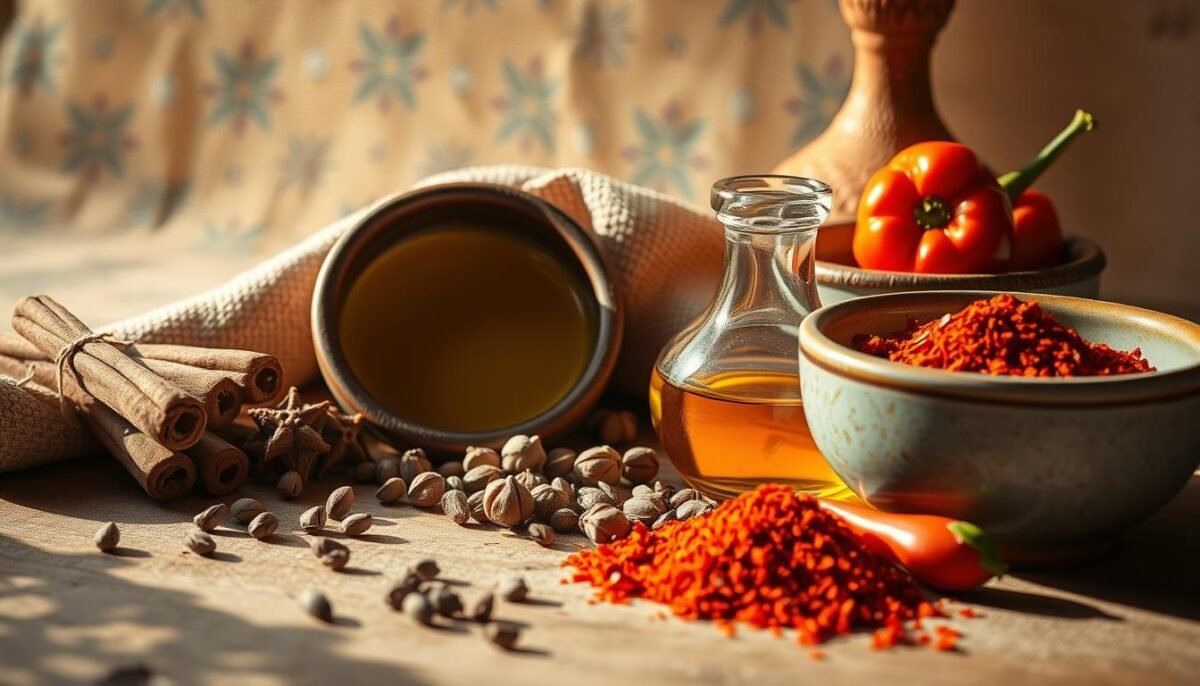
Tastes of Iran: Persian Rice, Kebabs, and the Magic of Saffron
May 2, 2025
Mastering Italian Pizza at Home with Authentic Neapolitan Techniques
May 3, 2025I still remember the first time I rolled a grape leaf. My hands trembled as I tried to mimic my aunt’s effortless motions – fold, tuck, roll – while the scent of lemon and garlic filled her sunlit kitchen. That moment taught me these dishes aren’t just meals. They’re edible stories, passed down through generations.
Years later, while perfecting kibbeh with Chef John’s guidance, I realized how these recipes balance tradition and creativity. Whether shaping spiced meat into golden patties or simmering stuffed vegetables with olive oil and red pepper, every step feels like honoring a legacy. Even Robert Shagawat’s grape leaf techniques echo my family’s methods – proof that authenticity thrives in shared kitchens.
What makes Middle Eastern cooking so special? It’s the way humble ingredients – cracked wheat, fresh herbs, earthy spices – transform into something extraordinary. Like the crispy bread served with smoky baba ganoush, or the tangy onion paste that elevates simple meats. These flavors don’t just feed the body. They stitch communities together.
Through trial and error (and many burnt onions), I’ve learned that texture matters as much as taste. Getting potatoes just right for kibbeh fillings can make or break a dish – a lesson I refined using tips from this guide on achieving perfect vegetable textures.
Key Takeaways
- Middle Eastern cuisine carries centuries of cultural heritage in every bite
- Traditional methods adapt beautifully to modern kitchens without losing authenticity
- Core ingredients like olive oil and garlic create signature flavors
- Mastering textures (like in potato-based fillings) elevates classic recipes
- Cooking becomes storytelling when recipes connect generations
Introduction to the World of Syrian Comfort Food
Cracking open a jar of homemade olive oil, I’m reminded how simple ingredients build complex flavors. My kitchen fills with memories when I crush garlic cloves – their sharp scent softening into warmth with lemon juice. This alchemy defines what food writers call “a taste tour of the Middle East in every bite”.
What makes these dishes sing? It’s the careful dance between bold elements. Red pepper flakes add heat without overpowering. Toasted cumin and coriander create earthy depth. Even the timing matters – onions sizzled just 5 minutes longer transform a basic base into caramelized magic.
I learned early that salt isn’t just seasoning here. It coaxes moisture from vegetables for stuffings and balances tart pomegranate molasses. My mentor once told me, “Measure spices with your heart, but salt with your eyes” – advice that’s guided me through countless recipes.
From bulgur-studded kibbeh to tomato-based stews, textures play starring roles. Crispy exteriors give way to tender fillings, while fresh herbs add bright contrast. These aren’t just meals. They’re edible geometry perfected over generations.
Later, we’ll explore regional twists – like swapping meats or adjusting spice blends. But first, let’s master the foundation. Your cutting board awaits.
The Origins and Rich History of Syrian Dishes
Unearthing the roots of these dishes feels like peeling back layers of time. Each spice tells a story of ancient trade routes, while cooking methods whisper secrets from Ottoman kitchens. Historical records show how Persian pilafs merged with Mediterranean herbs, creating the flavor foundations we cherish today.

Stories From My Family’s Kitchen
I learned the art of spiced ground beef fillings from my uncle’s steady hands. “Always toast cumin first,” he’d say, crushing garlic cloves into the sizzling oil. Our Saturday ritual: shaping rice-stuffed vegetables while he shared tales of his Damascus childhood.
Bread holds special meaning here – not just food, but edible utensils. My aunt would tear fresh loaves, declaring, “This is how we taste history.” Even simple ingredients like salt and black pepper became magical through her stories.
Time transforms these dishes. A 30-minute simmer turns tough cuts tender. A clay pot’s slow heat melds flavors better than any modern gadget. These techniques survived empires because they work – connecting us to cooks from centuries past through shared rhythms and aromas.
Preparing Delicious Kibbeh with a Twist
Mastering kibbeh taught me that tradition and innovation can coexist deliciously. My breakthrough came when I swapped lamb for beef in my family recipe – the earthy spices still shone through, but with a milder flavor that won over new fans. Chef LC Schmidt’s baked version, topped with tahini, proved these patties adapt beautifully to modern ovens.
Meat Choices Shape Flavor Profiles
Ground lamb remains the classic choice, its richness balanced by cracked wheat. But mixed meats create exciting textures – try 70% beef with 30% pork. For vegetarian options, mushrooms and walnuts mimic meat’s umami depth surprisingly well.
| Method | Texture | Time | Best Pairing |
|---|---|---|---|
| Fried | Crispy shell | 8 mins | Yogurt dip |
| Baked | Golden crust | 40 mins | Tahini sauce |
| Grilled | Smoky edges | 15 mins | Herb salad |
The secret sauce? Simmer tomato paste with lemon juice and garlic cloves for 10 minutes. This tangy base elevates even simple preparations. Ron Shepherd’s trick: add a pinch of salt to toasted bulgur before mixing with meat – it enhances every bite.
Balance is key. Too much cumin overwhelms, while skimpy allspice leaves flavors flat. I taste-test mixtures raw (yes, safely!) to adjust seasonings. Remember: great kibbeh should sing with spice harmony, not shout.
Discovering Yalanji and Stuffed Grape Leaves
The scent of simmering grape leaves always transports me to summer afternoons in my grandmother’s kitchen. She’d spread fresh vine leaves across the counter, their edges curling like parchment. “Each roll holds a secret,” she’d say, brushing them with olive oil that glistened like liquid gold.

Family Traditions Behind Every Bite
Robert Shagawat once described stuffing grape leaves as “editing a love letter to your ancestors.” I mix ground beef with rice, diced onion, and a pinch of black pepper – the same ratio my family’s used for generations. The magic happens when lemon juice meets garlic cloves in the cooking pot, softening sharp edges into harmony.
Timing transforms this dish. Simmer rolls for 40 minutes, and the rice swells like a sponge soaking up broth. Serve them warm with crusty bread to contrast the tender texture. My aunt’s trick? Sprinkle salt directly onto the leaves before rolling – it seasons from the inside out.
What makes these recipes endure? It’s not just the ingredients – though fresh herbs and quality olive oil matter. It’s the laughter shared while rolling, the stories traded over steaming pots. Every bite carries whispers of kitchens past, making even first-time tasters feel like family.
Syrian Comfort Food Recipes
The first time I tweaked my grandmother’s ground lamb formula, I discovered how tradition bends without breaking. Modern life demands shortcuts – but not compromises. My secret? A 20-minute marinade with lemon juice and garlic transforms even weekday dinners into vibrant feasts.
Balancing bold flavors starts with three essentials: olive oil for richness, red pepper flakes for heat, and salt for depth. Chef Amina Hassan once told me, “Measure citrus by the clock – 5 minutes too long and lemon becomes bitter.” This precision turns simple ingredients into layered masterpieces.
Timing makes or breaks these dishes. Simmer tomato-based stews for 40 minutes to meld flavors. Let rice rest 10 minutes after cooking for perfect texture. Even resting times matter – sliced onions need 15 minutes to mellow before mixing into fillings.
| Recipe | Traditional Method | Modern Twist | Time Saved |
|---|---|---|---|
| Kibbeh | Hand-shaped patties | Baked in muffin tins | 25 minutes |
| Stuffed Vegetables | Simmered on stove | Instant Pot pressure cook | 50 minutes |
| Lamb Stew | 6-hour slow cook | 3-hour Dutch oven | 3 hours |
For busy cooks, I swap labor-intensive steps without losing soul. Use pre-ground meat mixed with bulgur. Substitute jarred roasted peppers when fresh aren’t available. The goal? Keep the essence intact while respecting your schedule.
These creations shine as mains or sides. Serve kibbeh with yogurt sauce for dinner, or pack chilled grape leaves for picnics. Every bite proves heritage adapts – and that’s how recipes live forever.
The Essential Role of Olive Oil and Spices in Syrian Cuisine
The golden stream of olive oil hitting my grandmother’s clay pot always signaled magic was coming. This liquid gold doesn’t just cook ingredients – it coaxes out hidden flavors. Chef John once told me, “Bad oil makes good recipes taste lonely”, a truth I’ve tested through countless dishes.

Role of Olive Oil in Enhancing Flavor
Quality olive oil transforms simple meals. I drizzle it over bulgur salads to add richness, or use it to brown ground beef for stuffed vegetables. Slow-cooked meats gain silkiness when simmered in it for hours. The difference? Cheap oils smoke quickly, while premium varieties handle high heat while keeping their fruity notes.
My favorite trick: brush bread with garlic-infused oil before toasting. It creates a crispy base for dips like hummus. For frying falafel, olive oil’s high smoke point ensures golden crusts without bitterness.
Signature Spices and Their Impact
Baharat – a blend Buckwheat Queen calls “the soul of Middle Eastern cooking” – lives in my spice rack. Cloves and black pepper dominate this mix, adding warmth to rice dishes and meat rubs. I toast whole spices before grinding, releasing oils that pre-ground versions lose.
| Spice | Use | Pairings |
|---|---|---|
| Cloves | Meat marinades | Beef, onions |
| Black Pepper | Seasoning base | Bread, vegetables |
| Sumac | Finishing sprinkle | Salads, dips |
For authentic results, seek spices from specialty markets. Freshness matters – stale cumin tastes like dust. Store them in airtight jars away from light. Your pot of lentils will thank you.
Indulging in Middle Eastern Dips and Spreads
The first time I tasted freshly whipped hummus at a Beirut street market, I understood why dips rule Middle Eastern tables. Creamy textures and bold flavors turn simple ingredients into edible velvet. Chef John’s roasted red pepper spread – blitzed with walnuts and pomegranate molasses – became my gateway to this saucy universe.

Hummus, Baba Ghanoush, and More Favorites
Great dips balance richness with brightness. My trick? Blend tahini with ice-cold water first – it whips into fluffy clouds before adding chickpeas. For baba ghanoush, roast eggplants until their skins char. The smoky flesh pairs perfectly with lemon juice and garlic.
Tomato paste works magic here. A tablespoon stirred into yogurt creates instant depth. Mix it with olive oil and mint for a vibrant “red sauce” that elevates grilled meats. My aunt’s secret: let dips rest 30 minutes before serving. Flavors marry better than newlyweds in Santorini.
Pair these creations with:
- Warm pita brushed with garlic oil
- Crisp cucumber spears
- Radish slices for peppery crunch
Texture matters most. Over-blend hummus, and it turns gummy. Under-process, and you’ll crunch on chickpea skins. I pulse exactly 2 minutes – just enough to feel smooth without losing character. As Chef John says, “Dips should hug your tongue, not slap it.”
For parties, I arrange small bowls with contrasting colors – beet-dyed hummus next to emerald zhug sauce. It’s edible art that disappears faster than sunset over the Mediterranean.
Savoring Syrian Stews and Slow-Cooked Delights
Watching onions turn golden in olive oil feels like witnessing alchemy. As they sizzle, the kitchen fills with aromas of cumin and black pepper – a prelude to hearty stews that simmer for hours. These dishes transform humble ingredients into velvet-textured masterpieces through patience and low heat.
Beef, Lamb, and Vegetable Creations
My favorite middle eastern stew combines cubed beef with chickpeas and tomatoes. Brown the meat first – it creates a caramelized crust that infuses the broth with depth. Add garlic cloves and a pinch of salt halfway through cooking to layer flavors without overpowering.
For lamb stews, I toast coriander seeds before grinding. Their citrusy notes cut through the meat’s richness. Vegetarian versions shine too: eggplant and zucchini absorb spices like sponges, especially when cooked in clay pots.
| Stew Type | Cooking Time | Key Spices | Perfect Pair |
|---|---|---|---|
| Beef & Chickpea | 3 hours | Cumin, Paprika | Basmati Rice |
| Lamb & Apricot | 4.5 hours | Cinnamon, Cloves | Flatbread |
| Vegetable Medley | 2 hours | Turmeric, Sumac | Bulgur Salad |
Cool evenings call for bowls cradled in both hands. I garnish mine with fried onion slivers for crunch. The secret? Let stews rest overnight – flavors marry beautifully, making leftovers taste better than the first serving.
Whether using ground meat or whole cuts, balance is key. Too much pepper overwhelms. Too little garlic leaves the dish flat. Taste as you go – adjust until every spoonful hums with harmony.
Flavorful Side Dishes: Batata Harra and Beyond
The sizzle of potatoes hitting hot oil still makes my kitchen smell like a Damascus street vendor’s cart. Batata Harra taught me how texture and spice can turn basic ingredients into showstoppers. Crispy edges hug tender centers, while chili flakes and garlic cling to every golden cube like edible confetti.
Batata Harra: Spicy Potatoes with Garlic & Cilantro
Parboiling is key. I boil diced potatoes for 7 minutes before their olive oil bath – this creates a fluffy interior beneath the crunch. Toss them with fresh cilantro and lemon juice straight from the pan. The heat wakes up the herbs’ brightness. My trick? Add salt at different stages: in the water, on the potatoes, and in the finishing sauce.
Fasolia: Braised Green Beans with Meat and Tomato
For Fasolia, I brown ground beef with tomato paste until it caramelizes. Simmer green beans in this base for 40 minutes – they soften while soaking up rich flavors. A splash of lemon juice at the end cuts through the richness. Serve it warm with flatbread to scoop up every last bit.
Weeknight shortcut: Use frozen green beans and pre-minced garlic. The dish still sings with depth. Pair these sides with grilled chicken or stuffed grape leaves. They’re more than accompaniments – they’re food memories waiting to happen.
Time-Saving Cooking Techniques and Tips
My “aha” moment came when I realized tradition doesn’t demand endless hours. Modern life needs shortcuts that honor heritage without chaininɡ us to the stove. The secret? Strategic swaps that keep core flavors intact.
Traditional Methods Versus Modern Adaptations
Slow-simmered stews taught me patience, but pressure cookers deliver similar depth in half the time. I brown beef in olive oil first – that caramelized crust matters more than cooking duration. For falafel, baking instead of frying keeps the crispy exterior I love with less cleanup.
| Method | Traditional Time | Modern Time | Flavor Saver |
|---|---|---|---|
| Meat Marination | Overnight | 30 minutes | Yogurt + garlic |
| Spice Prep | Toast & grind | Pre-mixed blends | Cloves + black pepper |
| Vegetable Stuffing | Hand-chopped | Food processor | Fresh herbs |
Prepping components ahead transforms weeknight meals. I mix garlic and salt for multiple recipes on Sundays. Store-bought dough works for flatbread when time’s tight – just brush with olive oil before baking.
Quality tools make a difference. A heavy-bottomed pot distributes heat evenly, preventing burnt spices. For meat dishes, I sear in batches to avoid steaming – that golden color builds flavor foundations fast.
Balancing spices remains crucial. Pre-mixed blends save minutes without sacrificing taste. My go-to combo: cumin, coriander, and a pinch of cloves. Taste as you go – a dash of lemon juice can brighten any rushed recipe.
Creative Meal Prep and Serving Ideas
Meal prep Sundays transformed my kitchen chaos into organized joy. I discovered that pre-chopped herbs and pre-mixed spices save precious minutes during busy weeknights. For grain bowls, I cook bulgur in batches – its nutty flavor holds up beautifully for 4 days when stored with a drizzle of olive oil.
Storing components separately keeps textures intact. I keep roasted vegetables away from sauces until serving time. For dips, a squeeze of lemon juice before refrigeration prevents flavor fade. My favorite hack? Freeze tomato paste in ice cube trays for instant umami boosts.
Pairing Dishes With Rice and Flatbread
Hearty stews crave starchy partners. Fluffy basmati rice soaks up spiced broths, while warm flatbread scoops up every last bite. For vegetarian spreads, I layer hummus over bulgur pilaf – the contrast of creamy and chewy delights taste buds.
| Main Dish | Perfect Pair | Prep Tip |
|---|---|---|
| Lentil Stew | Garlic Naan | Add preserved lemon before serving |
| Spiced Kofta | Turmeric Rice | Mix chopped herbs into grain base |
| Roasted Veggies | Pita Chips | Toss with salt and za’atar pre-bake |
Presentation matters as much as flavor. I arrange stuffed grape leaves in circular patterns on platters, garnished with pomegranate seeds. For sauces, small bowls with colorful linens create visual pop. The secret? Odd numbers – three dips or five skewers look most inviting.
When time’s tight, I lean on freezer staples. Pre-rolled dolmas reheat perfectly in steamers, while frozen flatbread toasts in minutes. A quick sauce of yogurt, garlic, and mint ties everything together. These tricks let me savor traditions without clock-watching.
My Culinary Journey with Syrian Recipes
The first time I stirred tahini into a simmering pot, its earthy aroma whisked me back to my grandmother’s kitchen. Her hands moved like clockwork – crushing garlic with salt, folding mint into yogurt, transforming simple ingredients into stories. That moment sparked my love for these flavors, where every recipe feels like uncovering buried treasure.
Family kitchens taught me balance. Too much mint overpowered lamb dishes. Too little salt left stuffed vegetables flat. I learned to trust my senses – tasting as I cooked, adjusting spices until flavors sang. My cousin’s trick? Toast cumin in olive oil before adding potatoes. It deepened their richness without extra time.
Experimentation became my compass. Swapping lemon for pomegranate molasses in dips. Blending tahini with roasted peppers for creamier textures. Each tweak revealed new dimensions, proving tradition and innovation could coexist. Even failed attempts taught me more than perfection ever did.
These dishes hold memories sharper than any photo. The kibbeh I burned while laughing with friends. The stuffed grape leaves we rolled during thunderstorms. Every bite carries echoes of kitchens past, inviting others to join the story.
Your turn? Start with one recipe. Let curiosity guide you. Mix store-bought shortcuts with handmade touches. Taste, adjust, repeat. The magic lies not in flawless execution, but in the messy, joyful cooking journey itself.
Conclusion
Every time I toast cloves for stew, their warm aroma tells me I’m home. These flavors carry centuries of tradition – from earthy black pepper in meat rubs to zesty tomato bases simmering for hours. What makes this cuisine timeless? It’s how simple ingredients become extraordinary through care and creativity.
The dishes we’ve explored – crispy falafel, tender stuffed leaves, spiced potato sides – show how textures and tastes dance together. Whether shaping kibbeh or braising green beans, each technique invites personal twists. My grandmother’s secret? “Let your hands learn the rhythm, then make it yours.”
Don’t fear experimentation. Swap lamb for mushrooms in stews. Add smoked paprika to hummus. These recipes aren’t museum pieces – they’re living traditions that grow with every kitchen they touch. Your version might become someone else’s cherished memory.
Now it’s your turn. Roll grape leaves while music plays. Share flatbread dipped in garlicky yogurt. Remember: great food isn’t about perfection. It’s the joy of creating, tasting, and connecting. Your stove awaits – what story will your cooking tell?
FAQ
What makes olive oil so important in these dishes?
I love using high-quality olive oil because it adds richness and depth to everything from marinades to dips. It’s a staple in my kitchen for sautéing vegetables or drizzling over hummus and salads.
Can I substitute bulgur with another grain in kibbeh?
While bulgur gives kibbeh its signature texture, I’ve experimented with quinoa or rice in a pinch. Just adjust the spices and cooking time to keep the flavors balanced!
How do I prevent stuffed grape leaves from falling apart?
Rolling them tightly is key! I use a mix of short-grain rice and ground meat to help bind the filling. Simmering them gently in lemon juice and broth also keeps the leaves tender but intact.
What’s your go-to spice blend for stews?
I swear by a mix of cumin, coriander, and Aleppo pepper flakes. A dash of cinnamon or allspice adds warmth to lamb or beef dishes without overpowering the other ingredients.
Can I make batata harra less spicy?
Absolutely! Adjust the chili flakes to your taste and focus on the garlic and cilantro for freshness. A squeeze of lemon juice at the end brightens the dish perfectly.
Is tahini necessary for authentic dips?
Tahini gives baba ghanoush and hummus their creamy texture, but I’ve used Greek yogurt as a substitute in a hurry. The flavor will shift slightly, but it’s still delicious!
How do you balance traditional methods with modern cooking?
I honor slow-cooked stews and handmade doughs but embrace tools like food processors for dips. Time-saving tweaks let me enjoy the process without sacrificing authenticity.
What’s your favorite way to serve fasolia?
I pair braised green beans with fluffy basmati rice or warm pita bread. The tomato-based sauce soaks into the grains, making every bite flavorful and satisfying.



